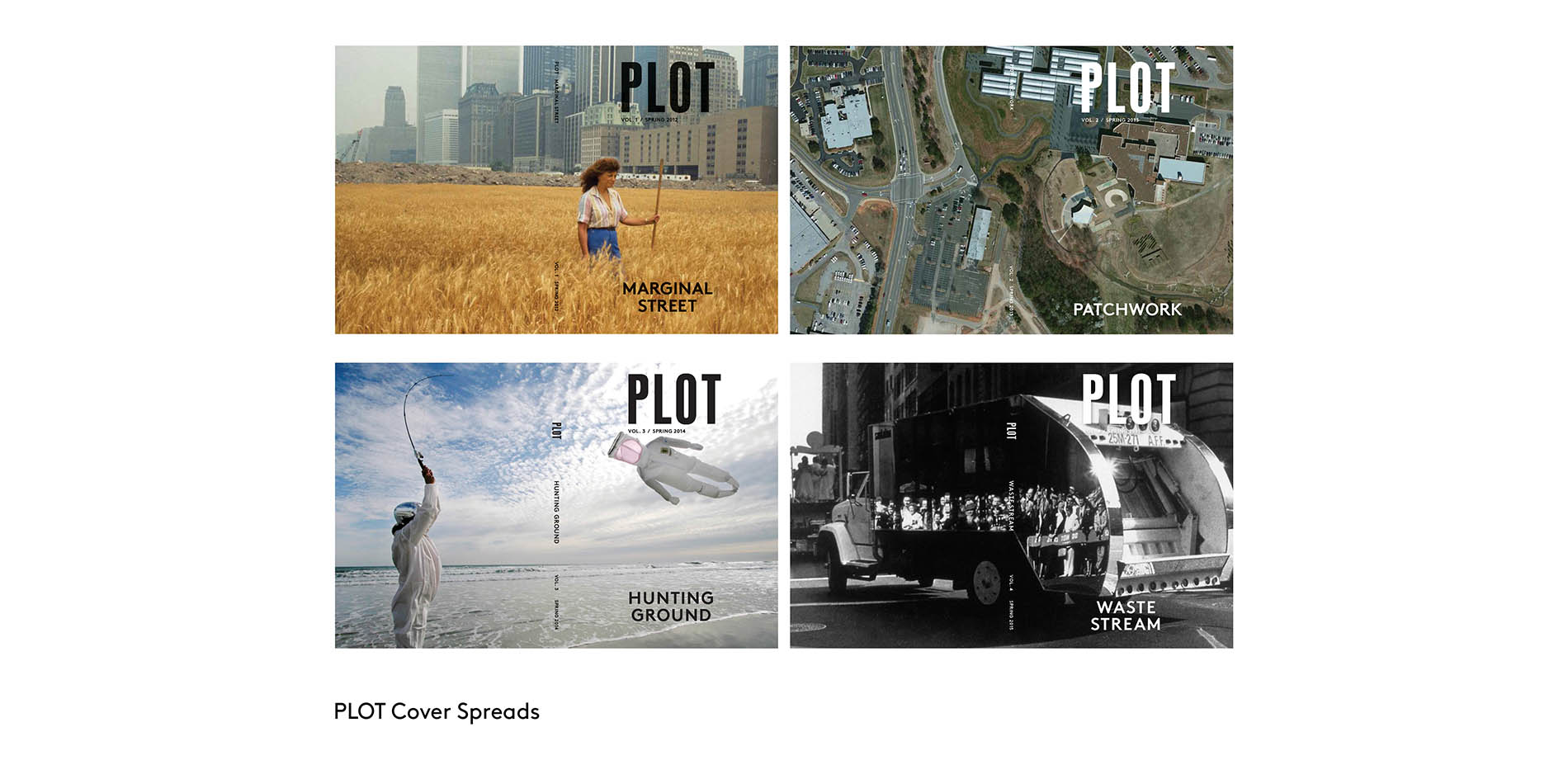PROJECT NARRATIVE
The annual landscape architecture journal PLOT is curated, edited, and produced by a team of graduate students in their second year of the Master of Landscape Architecture program. With a public launch of this print edition each spring, the journal is conceived as a thematic community platform for critical texts and design explorations encouraging collaborative discussion, reflection, and conversation around a contemporary theme selected annually by the student editors.
PLOT aims to explore emerging landscape phenomena as well as consider design thinking in the urban landscape. The first four volumes of PLOT have addressed the following themes: MARGINAL STREET, PATCHWORK, HUNTING GROUND, and WASTE STREAM. Each curated issue shapes new ways of collectively reconsidering the city, invented territories, and contested grounds. One particularly compelling aspect of this print journal has been the selection of cover images, each an image of the work of female land artists and performance artists operating within the urban landscape; these include Agnes Denes’ Wheatfield (1982), Barbara Kruger’s Picture This (1994), Pat Oleszko’s Darwin’s Nightmare (2013) and Mierle Laderman Ukeles’ The Social Mirror (1983). Each artwork captures a performative vision of the annual theme, and through their engagement with the student editors, each of these artists has become a “friend of the program,” engaging in discussions and presentations of their work with our student body.
With a public celebratory launch of the journal’s print edition each spring, followed by a fall rooftop film series curated by the incoming student editors in response to the content of the previous issue, the entire program is engaged around the annual topics of PLOT. Given the broad reach of the student editors and the range of submissions received, our audience has broadened to include not only our own community but prospective landscape architecture students, alumni, practitioners, professors, and friends of the program. Interest from local not-for-profit groups engaged with architecture, urban design, urban planning, and landscape architecture in our region has helped our audience grow, and we believe that PLOT has the power to inform and inspire our community. Below are brief descriptions of the thematic topics explored through the shaping of our first four issues of PLOT.
MARGINAL STREET, the first in the PLOT series, seeks to track emerging landscape phenomena as well as consider design thinking and the urban landscape. The theme Marginal Street is both an actual street name near our campus and a thematic metaphorical perspective; it is a space with which to frame dialogue and thoughts. Within urban areas there exist a number of streets, often extensions of off-ramps, former construction roads, or dead-end cul-de-sacs that are named Marginal Street. Discovering one such street while researching a particular Manhattan site, the student editors reflected on how often we investigate spaces and conditions that are dilapidated, in ruin, or somehow on the fringe. As students, we are determined to identify and explore these places as well as plot their significance.
The second volume, PATCHWORK, addresses the “patchwork thinking” that creates ad-hoc assemblages of ideas, much as a quilt is a pragmatic act of joining disparate pieces in revelatory ways. Patchwork thinking is both innovative and precise: it solves specific problems and addresses specific needs. We also see patchwork thinking as particularly urban; it’s a useful way of fixing things that have gone wrong, or embracing conditions emanating from between the cracks. Contributors to this issue are thoughtful observers of change, fluidity, and emergent systems in the city. This issue of PLOT shapes new ways of collectively reconsidering the city and its patchwork logic.
HUNTING GROUND, the third volume of PLOT, attempts to connect the search, or quest, to a terrain—what is the place of the hunt? Maps are invented and reinvented. Grounds are geocoded and often contested, by animals, humans, and machines, on digital screens and physical platforms. Here the notion of prey or capture is also explored. It is revealed in the collector’s obsession; whether soils, fossils, bodegas, or data, this gathering reveals a desire to contain and compress a fleeting moment. This issue of PLOT shapes new ways of collectively reconsidering the city, identifying its invented territories and considering its contested ground.
This fourth and most recent issue of PLOT reveals many interpretations of WASTE STREAM, from culture to terraforming to rethinking our own health and that of our planet. Over time, we’ve gotten more particular with our detritus, perhaps to the point of obsession. We classify, sort, rinse, crush, separate into neatly colored bins. But we don’t always quantify. We're producing more waste—measuring a day's personal accumulation is certainly one way to reflect on an increased ratio of consumption to production. Perhaps more important than reflecting on the stuff of waste is reconsidering those who maintain, manage, organize, and move our waste stream. How do we see them? Mierle Laderman Ukeles’s work creates uncanny connections between feminism, workers’ rights, and the environment. We are honored to wrap the amazing photograph of her 1983 performance of The Social Mirror around this issue of PLOT. Who’s that in the mirror? Just take a look…


















